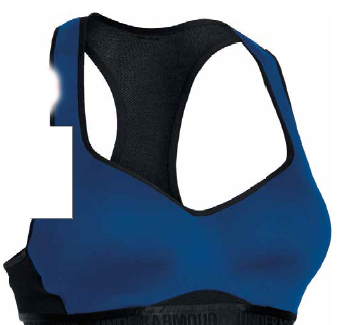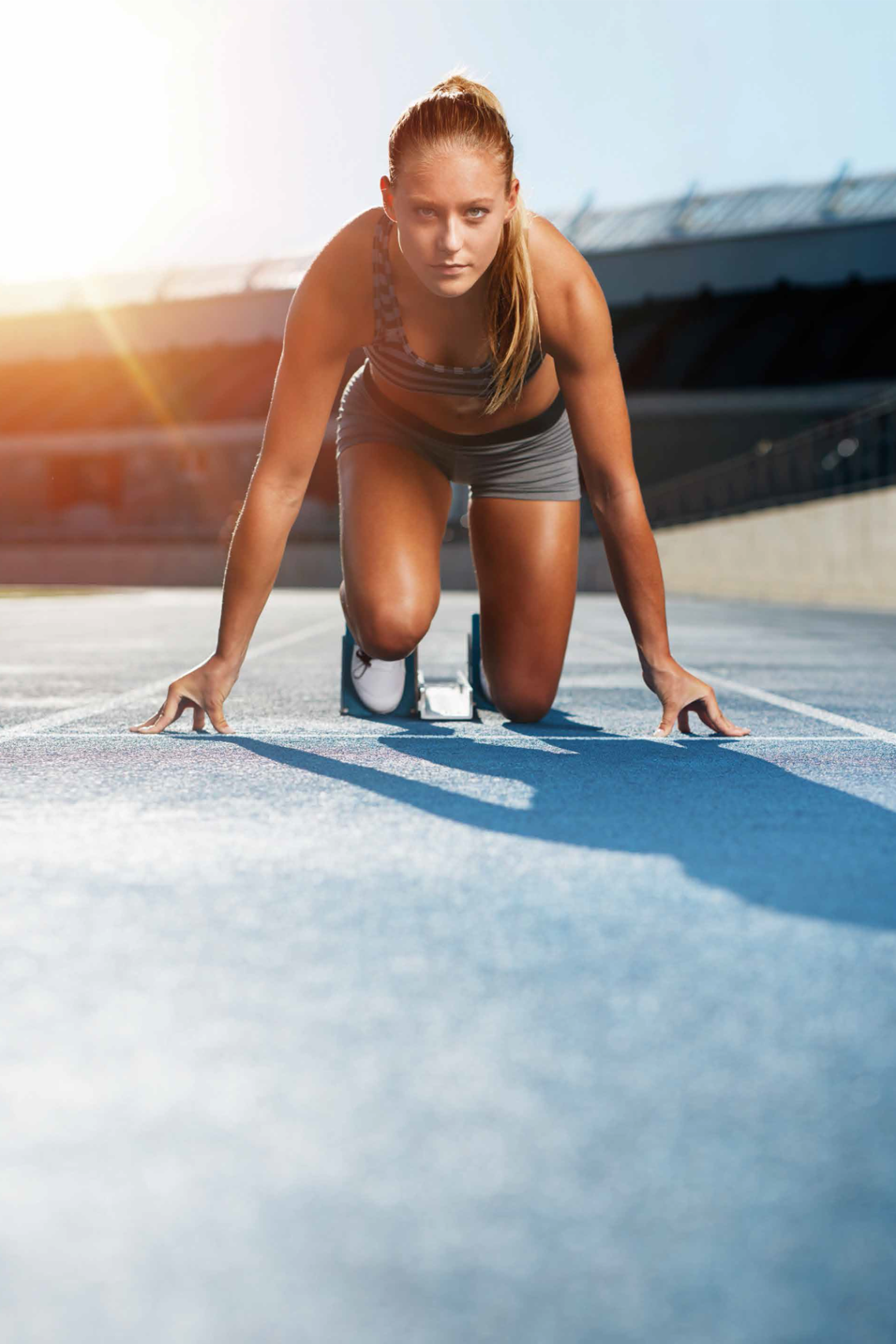You love to run. So let’s get you a sports bra that can pass our high-intensity support test.


You love to run. So let’s get you a sports bra that can pass our high-intensity support test.

We’re going to level with you: Running is the mother of all unrelenting high-impact workouts. For starters, each foot strike sends a jolt equivalent to two to three times your body weight right back through you in the form of something called ground reaction force. And when you consider that you’re pounding the pavement some 150-plus times per minute, you can see how running is tougher on breasts than stop-and-start types of plyometric (a.k.a. jumping) exercise are. In fact, around one in three female runners surveyed at the 2012 London Marathon reported that they had experienced breast pain. The good news? The right sports bra can reduce your bounce by as much as 74 percent.
Picture this: Your breasts don’t just go up and down as you run. When unsupported, they each move an average of 10cm in a butterfly pattern – up, down, side to side, and forward and backwards. “With up to 4 percent of your total body weight in your breasts, that’s a lot of demand on your natural support system,” says LaJean Lawson, an adjunct professor of exercise and sport science at Oregon State University in the US, who has been researching breast health and sports bras for 38 years.
It’s a common myth that firming up your chest muscles can give breasts a lift and extra support. “Breast tissue lies on top of the pectoral muscle,” LaJean says, which means that the breast itself has no muscle to give it structure. Instead, breasts are composed mostly of fat tissue (which surrounds tiny globular milk glands) held up by elastic connectors called Cooper’s ligaments. These thin, band-like sheets tether the breast tissue to the pectorals and are meant to stretch and then boing back into shape when breasts are in motion. Minimise the bounce and you’re sparing yourself some of that stretch. And the benefits go beyond stopping sag: Your breasts also contain tons of nerve endings, so you really feel the pressure and pain of a bumpy ride as you’re striding.
To lighten the jolts, start from the ground up. Harvard University researchers found that taking shorter, quicker strides can reduce the ground reaction force that is amplifying your bounce. The higher the cadence (the quickness with which your feet turn over), the less vertical lift-off you get, which translates to a softer impact.
Running at a cadence of 170 to 180 steps per minute (around 8km per hour for the average woman) or more is a good bet, says Irene S. Davis, the director of the Spaulding National Running Center at the Harvard Medical School. “The shorter strides also encourage you to strike farther forward on your foot, which provides better shock absorption at the knees and hips than when you strike with your heel,” Irene explains. Besides that, it’s all about wearing a good sports bra. If achieving your foolproof fit has so far been elusive, just follow these expert tips to finally experience running nirvana.
FIND YOUR IDEAL STYLE
For smaller breasts (As and Bs), it’s OK to go with sports bras labelled small, medium or large. But if you’re a full C or larger, it’s best to look for those sized by both the cup and the band, LaJean says.
Compression-style bras – pullovers that are not separated into cups – can work for up to a C, but if you’re a D cup or larger, encapsulation bras, which have separate non-stretch cups, will give you more support, she says. Also, only runners who require a D cup or fuller really need to look for bras with an underwire.
No matter what your size, skip low-cut styles. “When you’re running, breasts actually rise more than they fall, so check that the front of the bra is high enough to hold you down,” LaJean suggests.
DO THE STRAP TEST
Most of the weight of your breasts is actually held by the straps, LaJean says. “There should be more stability in the front of the strap, up to the peaks of the shoulder, and more give in the back,” she advises. To test a prospective sports bra, grab the top of a strap in one hand and the bottom of the rib band directly below it in the other, and tug. Do this both in the front and back of the bra. You’re looking for less stretch in the front straps than in the back.
Also, the wider the straps, the more the force of your breasts will be spread out over the fabric, which reduces pressure and digging in. “This is especially important if you have larger breasts or are going on a longer run,” LaJean explains. Meanwhile, the bottom rib band acts as the anchor of support; bands with hook-and-eye closures let you customise snugness even more.
TRY A TEST DRIVE
“The goal is to be secure and comfortable, whatever it takes,” LaJean says. That means jumping around in the fitting room to get a feel for the sports bra in action before deciding to buy it. When you bend, swing or raise and lower your arms, the bottom rib band of the bra should not move. If it does, try a smaller band size.
A WORD ABOUT YOUR BRA’S MILEAGE
Washing and use will wear out the stretch and recovery of your sports bra, so pay attention to signs that it may be time to toss it. If you wear the same sports bra three or four times a week, you’ll need to replace it in six to 12 months, LaJean says. If it no longer feels secure, the back of the rib band is riding up higher than the front, or the straps are sliding down your shoulders, it’s definitely time to go shopping. Wash your new bra in warm water, avoid detergent containing chlorine, and hang-dry instead of throwing it in the dryer.

FOR SHORT RUNS
Chafing and rubbing are less of a problem when you’re at it for only a half hour or so, which is why most strap styles – especially racerback and crisscross – are fair game, says LaJean Lawson, a sports bra expert. (Also, C cups can get away with a compression style here.)



DIGITAL EXCLUSIVE! View close-up shots of the sports bras featured in this story! The digital edition of Shape is available for download at the App Store and Google Play.
FOR LONG RUNS
Your goal is to minimise chafing, which frequently happens if you’re running for more than an hour, LaJean says. Look for U-back or open-back styles, which are less likely to rub against shoulder blades. Straps that are adjustable also let you reposition on the go if you feel any discomfort.



FOR SPRINTERVALS
HIIT sessions are probably your sweatiest runs, so moisture management is the aim, LaJean says. Look for brands that tout sweat-wicking fabric (most sports bras have it these days), as well as mesh zones or holes for ventilation.



SMART TRAINING
Keen to improve your running performance? Look no further. From the best sports bras for different distances (it’s not a one-size-fits-all!) to essential pre- and post-run stretches, our comprehensive guide has got you covered. Stepping up your game includes gaining a stronger physique all around – our Look Hot From Behind workout will help you achieve just that, so that you can run faster, jump higher and improve your posture. Clocking up those kilometres also often results in sore, aching muscles, so remember to pamper your body with our post-workout treatment recommendations. Enjoy!
























